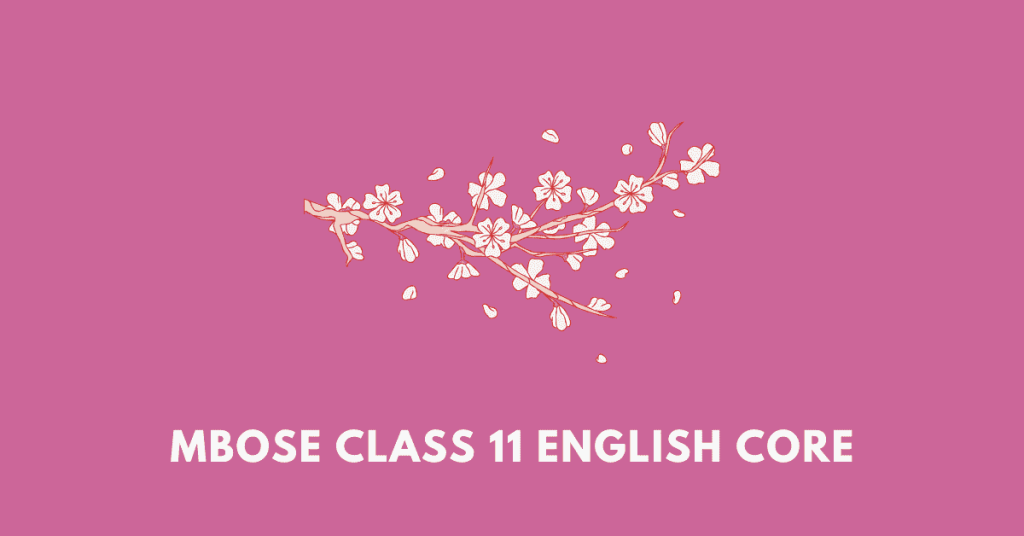Get summaries, questions, answers, solutions, notes, extras, PDF of Class 11 English Core textbook (Resonance) which is part of the syllabus of students studying under MBOSE (Meghalaya Board). These solutions, however, should only be treated as references and can be modified/changed. Please select the chapter you need and proceed.
About MBOSE Class 11 English Core textbook Resonance
The MBOSE Class 11 English Core textbook, “Resonance,” provides an enriching and varied literary journey through its prose and poetry sections, each offering insightful explorations of human experiences, nature, and historical events. The textbook is designed to cultivate a deep appreciation of literature among students, encouraging them to engage critically with the texts and reflect on their broader meanings.
The prose section opens with “We’re Not Afraid to Die… If We Can All Be Together,” a story that epitomizes resilience and unity. The narrative follows a family’s ambitious dream to sail around the world, mirroring Captain James Cook’s historic voyage. Their meticulous preparation over sixteen years and the professional construction of their ship, the Wavewalker, underscore their determination and attention to detail. The family’s journey, however, turns perilous when they encounter a massive storm. Despite the life-threatening challenges, the family’s collective courage and unwavering support for one another shine through, ultimately leading them to safety. This story serves as a testament to the power of perseverance, familial bonds, and a positive attitude in overcoming adversities.
“Discovering Tut” transports readers to ancient Egypt, delving into the intricate process of mummification and the significance of preserving bodies for the afterlife. The narrative explores the efforts of the Egyptian Mummy Projects, which aim to unearth and study mummies, providing invaluable insights into ancient Egyptian civilization. Through modern techniques like CT scanning, researchers can non-invasively examine mummies, uncovering details about their age and cause of death. The author, A.R. Williams, a noted researcher of ancient Egyptian history, brings to life the mysteries of the Valley of the Kings, enhancing our understanding of this fascinating period.
“The Ailing Planet” shifts the focus to environmental issues, highlighting the alarming rate of deforestation and its detrimental impact on the Earth’s ecosystems. The narrative stresses the urgent need for sustainable practices to protect the planet’s biological systems, which are vital for human survival. By drawing attention to the ongoing destruction of forests, the text urges readers to consider the long-term consequences of their actions on the environment.
In “The Portrait of a Lady,” Khushwant Singh offers a poignant depiction of his relationship with his grandmother, reflecting on the changes in their bond over the years. As the grandson grows up and the grandmother ages, the narrative beautifully captures the transition from a close-knit relationship to one marked by solitude and introspection. Singh’s evocative writing highlights the enduring love and respect within the traditional Indian joint family system.
“The White Seal,” adapted from Rudyard Kipling’s “The Jungle Book,” presents a touching story about Kotick, a young seal on a quest for a better life. The narrative uses personification to draw parallels between the seals and human adolescents, emphasizing themes of leadership, moral support, and the influence of peers. Kotick’s journey mirrors the challenges and aspirations of young individuals striving to carve their own paths in life.
The poetry section of “Resonance” is equally captivating, beginning with “The Kingfisher” by W.H. Davies. This poem celebrates the beauty of nature, focusing on the vivid imagery of the kingfisher, a solitary bird known for its striking colors and fishing prowess. Davies’ keen observation of nature reflects his deep appreciation for the natural world.
A.K. Ramanujan’s “The Striders” explores the delicate movements of water striders, insects that effortlessly glide across the water’s surface. The poem’s vivid imagery and meticulous description of the insects’ behavior offer a meditative reflection on the simplicity and grace of nature.
“To the Pupils of Hindu College” by Henry Louis Vivian Derozio is a heartfelt tribute to the poet’s students, capturing the joy and fulfillment he derives from witnessing their intellectual growth. The poem underscores the profound impact a dedicated teacher can have on shaping young minds.
“Childhood” by Marcus Natten reflects on the transition from innocence to maturity, questioning when and how one ceases to be a child. The poem’s introspective tone and exploration of disillusionment resonate deeply, highlighting the complexities of growing up.
Finally, Walt Whitman’s “In Paths Untrodden” celebrates the liberating power of solitude and the courage to deviate from societal norms. Whitman’s contemplative verse encourages readers to embrace their individuality and seek their own paths in life.
Overall, “Resonance” is a thoughtfully curated collection that not only broadens students’ literary horizons but also encourages them to ponder deeper existential and ethical questions.
Get notes of other classes and subjects

